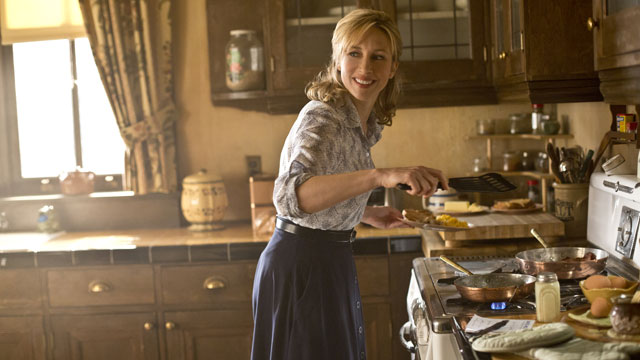 Jean Paul Sartre once said that evil is a product of making abstract that which is concrete.
Jean Paul Sartre once said that evil is a product of making abstract that which is concrete.
That’s some cool sounding shit right there. Of course, his true meaning is well beyond my grasp. Jean Paul was a big picture kind of guy with a voracious appetite for railing on the inequities of a world whose method is pure madness. I tend to steer clear of deep thoughts unless I’m wearing floaties, or drinking beer. Both . . .
Anyways, I’m hijacking the French philosopher’s intellectual property for the sake of a post . . about villains. The romanticized ones of stage and screen, whose mercurial tendencies are cooler than an old school Martini; whose cult of personality wins us over in spite of the mayhem they create with their existential middle fingers. As for that lovely shot of Vera Farmiga? It follows my Vera Farmiga Rules
Cayman’s Vera Farmiga Rules:
Vera’s allowed to show up whenever she damn well pleases. Because she’s Vera Fucking Farmiga. If that’s not a good enough reason to include her in this bad guys post, gimme a minute and I’ll think of something.
With few exceptions, the bad guys in reality are pedantic and crude. There’s no gray area when it comes to villains such as Hitler, Manson and the Kardashians. The concrete understanding of the bad guy only becomes abstract- and thus, quite pliable- when the antagonist is written rather than born. This is where badassery becomes high art.
As for those villains of stage and screen, I’ve been a fool for ’em ever since Darth Vader made long, black capes fashionable again. The contrast between bad ass father and do good son made it easy for me. Luke wore white. He contemplated the fate of the galaxy and his place in it on a daily basis. Dad blew up planets just to make a point. Game? I’d like you to meet set and match.
The Dark Knight is a fairly interesting fellow in his own right. But even he needed a little help from his bad ass friends in order to get three blockbuster movies out of a well worn franchise. Joker is a Hall of Fame villain in my book. He’s a natty dresser who doesn’t give a fig about the way things are because he sees the mind numbing hypocrisy of convention. He puts the hilarity in anarchy. I admire that. Catwoman ain’t gonna let no glass ceiling stop her. Bane is the most exciting thing to happen to Pittsburgh football since Lynn Swann. Harvey Dent didn’t get interesting until half his face burned off. And Ra’s al Ghul launched Liam Neeson’s incarnation as an action hero. Pretty super, if you ask me.
Let’s face it, without Hannibal Lecter, Silence of the Lambs is a CSI movie. He’s a zombie with a PhD whose vigilantism is endearing. Jaws is Nova without a man eating shark. If Jack Torrance doesn’t lose his mind, he’s just a writer trying to get published. Ho . . hum. The only reason Verbal Kint would be published is because he derived all that mad creativity from his days as a cold blooded killer.
The Way of the Bad Guy is perhaps best exemplified in mob flicks. Tony Montana gave us this classic bad guy walk off. If Tony was a bodega owner rather than a coked up millionaire drug lord, this scene is relegated to YouTube (Keyword: Crazy Uncle Refuses to Pay Market Fare).
Mob movies are where the bad guys really shine. Seriously, if the gang from Goodfellas is bad? Why would you want to be good? The silver screen alchemy of the mafia is a magical phenomenon. Hacking up a guy in your trunk isn’t so humorous in real life. On the big screen? It’s fucking hilarious.
The Godfather is like the Bible, in that every lesson on life can be found within its pages. And while that’s all well and good, the thematic resonance of fallen angels is what fuels this timeless masterpiece. I was captivated by Sons of Anarchy once I discovered the DNA of Michael Corleone was coursing through the veins of Jax Teller. Complicated men whose best intentions led them down a ruthless path of destruction from which they could never escape. That’s what makes the bad guys so very interesting to me.
As a fan of Walking Dead, I’ve watched Rick Grimes go from gun toting sheriff to bad ass gangster. He’s no longer protecting the gang from the bad guy. He has become the bad guy. Carol too. Theirs is the necessary evil of a world without rules. The subtleties of their transformation were hidden in the long, slow march on the outside. Alexandria has revealed their monstrous alter egos. As far as I’m concerned, the volatile properties of their current state make them infinitely more dynamic. Eat your hearts out Bonnie and Clyde, before they do.
I must confess that Norman Bates failed my bad guy analytics until Bates Motel gave him new life. Before that, he was little more than a reluctant social commentator on the perils of expansionism. So he killed a few guests, big whoop. Anyone who works in the service industry can relate to that. He didn’t break bad- for me- until he got the crazy hot mom to coach up his inner demons.
Vera as a bad ass . . it’s almost too good to be true.
Add? Meet endum. . .
It has come to my attention that this blog post on bad asses omitted one of the all timers in Lorne Malvo of Fargo. Every once in a while, an actor takes the written page and turns it into “Holy shit! Did you see that?!”. That’s what Billy Bob Thornton was doing across ten classic episodes.
Lorne Malvo’s moral turpitude lends itself to some of the most wickedly memorable scenes this side of the Coen Brothers. He’s got more angles than Frank Lloyd Wright. He’s meaner than a rabid junkyard dog . . on PCP. He’s more calculating than IBM’s Watson. He’s evil concentrate. And I could not get enough of him.
Big props to Mama Mick for her kick save, it was a beauty.

Loved this, Cayman! Your writing always gives me great perspective.
It made me think of all of my favorite bad guys and why they are my favorite characters: Billy Bob Thornton as Lorne Malvo in Fargo, Al Swearengen in Deadwood…And who is Dorothy without the wicked witch?
Mama- HOW did I forget Lorne Malvo? I loved that character! I might have to write up an addendum to this post. It’s a good thing you’re around, I swear. I don’t know Al Swear-word guy, but if you’re mentioning him, I know to do some homework. And yes, the wicked witch completed Dorothy, for sure. Nicely done, sharp and spot on analysis there. Love it.
I LOVED Deadwood – it was so well-written and the nuances were amazing. I loved that the good guys and bad guys often looked the same – kinda like Fargo, eh?
This Deadwood sounds like something I’ll have to check out at some point. And yes, very nice call on Fargo. Did you hear they’re doing Season 2?
Season 2? I’d watch that – though, who’s even left?!
It’s going to be a prequel featuring Keith Carradine’s character, Lou Solveson.
J. P-S also said ‘jazz is like a banana – it has to be consumed on the spot’. Not relevant, but interesting, I feel . . . .
Mr Jones, that’s classic stuff. Love it.
Another hit pilgrim. That Vera shot was totally appropriate and in keeping with the rule. Thank you.
Thank you John, I knew you would get it…
I laughed out loud at this: “so he killed a few guests. Big whoop. Anyone who works in the service industry can relate to that.” I guess we’ll let Norman off the hook, because waiting on people really sucks.
As far as my fave bad guy, I’m a sucker for the ones who show how kind they can be. The more human they are, the scarier they are.
I have to agree. When they add random acts of kindness to their repertoire of murder and mayhem, that there is someone you don’t ever want to cross paths with…
It was Fargo that introduced “wood chipper” into the lexicon.
I’ve often wondered if that would actually work.
Not that I’d ever try and find out…maybe.
From what I’ve heard, the femur is so dense that it usually ends up blowing out the engine. From . . . what I’ve heard…
To this hearty crew, I’d add Boyd Crowder from Justified. He is such a silver-tongued devil, I’d follow him anywhere.
As for the wood chipper scene in Fargo, it was based on an actual case. A guy from CT, a pilot and constable, killed his wife and put her body through a wood chipper. Did a pretty good job of it, too, but there were “bits” he neglected to clean out. It only takes a sliver of finger nail and some bloody bits to get DNA.
I hear great things about Justified. Not sure where I fit that in, but maybe I am just gonna have to try.
A huge Fargo fan here, and I had no idea as to the wood chipper story.See? This is why I will never, ever get married again. The idea that “death do us part” might end in a wood chipper, that’s more commitment than I’m ever gonna be up for. Yikes.